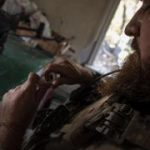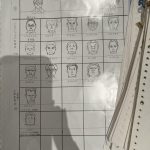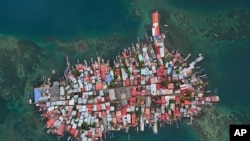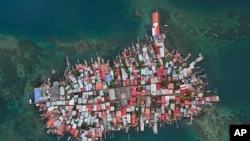Recently installed in their new houses on the mainland after leaving a small island in the Panamanian Caribbean hit by rising sea levels, some displaced indigenous people immediately placed their traditional hammocks on the porch to take advantage of a light breeze that came from the mountains in a hot afternoon.
“Now it’s cooler, there (on the island) at this time that’s an oven,” said Augusto Walter, 73, who moved in on Wednesday morning and was waiting for his wife, who had stayed a little longer. on the island preparing food. Three other relatives will live in the house. He brought his hammock, which is what is mostly used for sleeping and resting on the island.
The Guna inhabitants who have left their crowded homes on Gardi Sugdub Island this week are occupying their new homes although they face a setback: they need to have electricity installed and drinkable water to reach them.
Most of the 300 families on the island had moved their belongings in boats and vehicles until Wednesday afternoon to the new houses of the community named Isberyala, established on what was formerly a land for growing cassava in the Guna region. Yala, surrounded by mountains.
Civil protection officials said they hope to finish that operation on Thursday. Around seven or eight families, with about 200 members, will remain in Gardi Sugdub, according to their authorities.
It is the first of more than 60 towns on the Caribbean and Pacific coasts of Panama that will have to move to safer areas in the coming decades due to the rise in sea level associated with global warming.
Ernesto López, 69, moved in with his wife Digna on Tuesday. Two other relatives will later join the new home in Isberyala, which is just over half an hour’s walk from the port of Cartí, which connects Gardi Sugdub and other islands that attract tourism.
“We feel that here we are more comfortable, with more space,” he assured The Associated Press López sitting in a hammock that he also placed in the doorway of his new house in the neighborhood with paved streets and names of legendary sailas, the highest authorities in the Guna ethnic group. “In Gardi Sugdub we were very cramped in housing for many people, there was no room anymore and the sea got in on us every year.”
Like most of the families who have moved, López and his wife still did not have electricity or drinking water, according to what he found. AP during a visit to the place. They helped themselves on their first night on the mainland with a battery-powered lamp they brought from the island and two gas stoves to cook their food.
Early on Wednesday, López took his machete and went to a crop field that is a couple of hours from the new house and that a river crosses it. He encountered a large snake but managed to bring bananas, mangoes and sugar canes which he placed on the cement floor of the house.
“From time to time we will also cross to the island,” said López, who is one of the sailas in Gardi Sugdub.
Many recently moved families have chosen to return to the island in the afternoon due to the lack of electricity in their homes. Housing Ministry officials said that the new neighborhood has electricity and night lighting in the streets, but that each house has to make a contract with the electric company to receive prepaid service, something that is unknown when they will be able to formalize. Regarding water, they indicated that four wells were put out to tender to provide vital liquid to the community, but that if there were any problems with the electricity, the plant that sends water to the houses would stop operating. They assured that they had no reports of damage from the contractor, but that they were going to investigate.
Betsaira Brenes, 19, moved on Wednesday with her mother, her grandmother and an aunt on a day of strong sunshine and a lot of activity on the island and the port due to the move. The port and Gardi Sugdup are only a few minutes away by boat.
“It’s not that the house is big, but the space is enough for us, we lived on a suffocating and overcrowded island for quite some time,” she said while carrying two gallons of water to the new home she brought from Gardi Sugdub. “Of course we are going to miss everything there and I especially miss the dance afternoons.” On the island there is a house where the traditional Guna dance is practiced.
The new development in the middle of the humid forest currently has courts to play basketball and volleyball, a large house with a thatched roof and adobe walls for meetings of high authorities that was inaugurated in April, and another to celebrate a traditional ceremony. of the Gunas, who populate almost 50 of the 365 small islands of the Caribbean archipelago of Guna Yala.
“The good thing about all this is that now we have a new house and another where other aunts stayed” in Gardi Sugdub, Brenes said.
The houses in Isberyala – which in the Guna language refers to the loquat tree – are 40.96 square meters, with two bedrooms, a living-dining room, a bathroom and a small tub in the back for washing clothes. The 300 houses – intended for the same number of families – attract attention with their brick-colored roof and walls painted in cream and mustard, with paved streets and a small park with cement seats.
Built at a cost of more than 12 million dollars by the government, the homes have a 300-meter plot of land in the back that their owners can use to expand them or plant vegetables or other crops there, which will be part of the new change they will have. What to do on dry land.
On Wednesday, while belongings of the last families who were moving continued to be transported from the island to the port – such as mattresses, gas cylinders, furniture, children’s stuffed animals, solar panels, beds and stoves – many inhabitants also remained indifferent to the transfer. and determined to remain on the island despite the rising seas. Pets—dogs and cats that are abundant on the island—were not being transferred to the new homes on the mainland at the moment.
“I’m not very interested in the transfer because I’m not going to live with them, I prefer to be here, it’s more relaxing,” said Augencio Arango, 49, sitting on a dock from where you can see other nearby tourist islands.
He did not believe that climate change was responsible for the move, but rather decisions made by people. “Man is the one who damages nature. “Now they want to cut down all the trees to make houses on dry land.”
“The little animals stay here because the chiefs (the indigenous authorities of the island) do not want them to be moved because there are snakes and the tigers can attack them and cause accidents for the families,” added Arango, who is a mechanic’s assistant in a boat engine workshop, fisherman and also earns money in activities related to tourism.
He said that his mother, grandmother and brother will move to Isberyala and that he will stay in Gardi Sugdub with his aunts.
“I honestly don’t know why people want to live there. It’s like living in the city, locked up and you can’t go out, and the houses are small,” she lamented.
Simultaneously with the moving work, in Gardi Sugdub – where you can see portraits of venerated sailas painted on the old walls in the narrow streets, the red, yellow and green flag of the indigenous group and phrases alluding to their revolution for their lands and self-determination a century ago—other activities took place on Wednesday. At his school, students and teachers, during these vacation days, weighed dozens of bags full of aluminum cans collected on the island, as part of a recycling operation to obtain funds.
Some workers were advancing a few blocks away in the construction of a two-story wooden house, which they estimate could cost $15,000, something surprising in the midst of a historic displacement on the island.
“We are not going to leave,” said one of the indigenous builders, Robertino Martínez, 53 years old. “That will be until death comes.” The island cemetery is located on the mainland.
Connect with the Voice of America! Subscribe to our channels Youtube, WhatsApp and to the newsletter. Turn on notifications and follow us on Facebook, x and instagram.





![[Img #74683]](https://thelatestnews.world/wp-content/uploads/2024/12/The-main-mistakes-to-avoid-when-betting-on-electronic-sports-150x150.jpg)












Add Comment